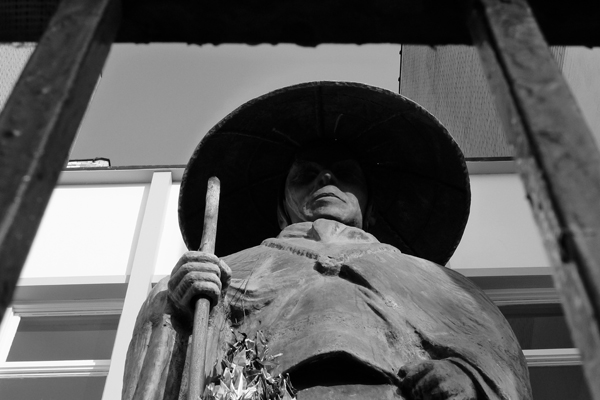Filed under: Uncategorized
Shinran was a Japanese Buddhist monk that lived between 1173 and 1263. Today, you can find a fifteen foot bronze sculpture of him in front of the New York Buddhist Church on Riverside Drive between 105th and 106th streets.
What’s remarkable about this statue, and why we’re including it in our Geologic City project, is that it once stood in front of a Buddhist temple in Hiroshima, Japan, a place where three waterfalls flow. On August 6th, 1945, this area was located less than 2.5 km from ground zero of the first nuclear bomb to be “used as weapon.” On the day when over 150,000 people died and 90 percent of the buildings in Hiroshima collapsed or burned–the Shinran statue persevered.
Reverend T. Kenjitsu Nakagaki of the New York Buddhist church says of the piece, “The statue stood alone in the middle of all the burning. This gave the people some kind of hope. It is now the focus of an annual peace gathering held on August 5th when a bell is tolled at 7:15 p.m. At that moment in Japan, it is 8:15 a.m. on August 5th, the hour that the bomb was dropped.”
Though pocked and blistered, the statue is incredibly intact. It’s also enormous. Shinran’s presence seems to fill the New York City block that he has quietly surveyed since September 11, 1955.
The statue was donated to the Church by Mr. Seiichi Hirose, who sought to have the statue donated to the United Nations as a symbol of the work for nuclear disarmament and world peace. The UN refused the offer and Rev. Hozen Seki, the founding minister of the New York Buddhist Church, offered to receive it at his Church instead. On the day of its unveiling, D.T. Suzuki gave a keynote address for world peace and harmony. The day we visited, less than a month after this year’s annual gathering, origami peace cranes were still hanging from one of Shinran’s hands. 2010 marks the 65th year anniversary of the bombing and 55 years since Shinran arrived on Riverside Drive.
Shinran’s geologic materiality is complicated–and incredible. Technically, he’s made of bronze, which is remarkable in itself as we discovered last week (materials used to make bronze originated in the stars, billions of years ago). It’s also remarkable because as metals became scarce in Japan during World War II many bronze statues and ornaments were melted down to be used for the war.
In the coming weeks, we will be researching just how the bronze of this statue has been altered by being subjected to the immense force of the atomic blast. We have read that the intense heat caused the metal to change color, resulting in the red markings on the lower half of the statue. How else did that event transform this statue’s materiality?
We’re also in the midst of considering where to place the Shinran’s statue in our geologic timescale. Its elements are travelers that arrived on earth from the deep cosmic past. They were transformed by human hand into metal and statue. Then, at the cross hairs of the geologic and the human, where the human hand took up the nuclear force and became a geologic force in ways entirely unprecedented, the statue’s elements were transformed into something else. Does this make the statue’s materiality Precambrian or Anthropocene? Arguably both. Yet, it also seems that the statue’s materiality exceeds both of these categories. Its continuous existence through such an incredibly vast expanse of “pre-Earthian” time and space–and its intense exposure to an earthly the “remixing” of the geologic through nuclear forces released by the human hand–have marked it, literally. As the material residue of the human-made geologic event of August 6, 1945, this statue undoes the logic of the geologic timescale.
 Shinran stands in front of an anomalous modern facade, tucked between standard Upper West Side architecture
Shinran stands in front of an anomalous modern facade, tucked between standard Upper West Side architecture
So, as we continue our work for Geologic City, we’ll be considering just how to handle such instances. How we might broaden our project to locate New York’s architecture and infrastructure within a geologic timescale, but also account for other forces in play–forces in addition to time that shape how we experience urban geologic materiality today: cultural context, geography, global flows and more raw-ly speed, pressure, heat, and light.
“One cannot turn away unchastened from the blistered statue of Shinran Shonin outside the New York Buddhist Church on Riverside Drive, a figure of gently imposing nobility that somehow survived the atomic bombing of Hiroshima.” — David W. Dunlap (New York Times, January 25, 2002)
| additional Geologic City reports can be read here: intro, 1 , 2 , 3 , 4 , 5 , 6 , 7 , 8 |
3 Comments so far
Leave a comment















[…] of the fossils that are drawn from the tar pit, connects with our lives today. They’ve recently written about the geological history of a statue Shinran, a Buddhist monk who lived between 113 and 1263, […]
Pingback by A Palaeontologist Walks into a Bar: A speculative Account of Cocktail Bars « bibliostructures 09.10.2010 @ 10:51 pm[…] Forces beyond Time (Geologic City Report #2) […]
Pingback by Urban Infrastructure as Geologic Material in Motion (Geologic City Report #8) « Friends of the Pleistocene 11.30.2010 @ 9:28 am[…] the Pleistocene blog: Introduction 1. Pre-Earthian New York City: Inwood Hill and Fort Tryon Park 2. Forces Beyond Time: Shinran Statue 3. Staten Island’s Tainted Edge: 2377-2387 Richmond Terrace 4. Stepping into Time: Rock […]
Pingback by Urban Omnibus » Geologic City 12.15.2010 @ 12:04 pm